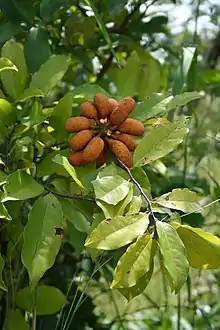| Uvaria chamae | |
|---|---|
 | |
| Finger-root | |
| Scientific classification | |
| Kingdom: | Plantae |
| Clade: | Tracheophytes |
| Clade: | Angiosperms |
| Clade: | Magnoliids |
| Order: | Magnoliales |
| Family: | Annonaceae |
| Genus: | Uvaria |
| Species: | U. chamae |
| Binomial name | |
| Uvaria chamae | |
Uvaria chamae, commonly known as finger root or bush banana is a climbing large shrub or small tree native to tropical West and Central Africa where it grows in wet and dry forests and coastal scrublands.[1][2] The common name refers to the fruit growing in its small bunches; the fruit is edible and widely eaten. U. chamae is a medicinal plant used throughout its range to treat fevers and has antibiotic properties.[2] An extract of Uvaria chamae, administered orally at 300–900 mg/kg/day showed significant antimalarial activity against both early and established infections.[3]
References
- ↑ Bongers, F.; M. P. E. Parren; D. Traore, eds. (2005). Forest Climbing Plants of West Africa: Diversity, Ecology and Management. CAB International. ISBN 0-85199-914-X.
- 1 2 Iwu, Maurice M. (1993). Handbook of African Medicinal Plants. CRC Press. ISBN 0-8493-4266-X.
- ↑ Okokon, J. E; Ita, B. N; Udokpoh, A. E (2013). "The in-vivo antimalarial activities of Uvaria chamae and Hippocratea africana". Annals of Tropical Medicine & Parasitology. 100 (7): 585–90. doi:10.1179/136485906X118512. PMID 16989684. S2CID 46151429.
External links
This article is issued from Wikipedia. The text is licensed under Creative Commons - Attribution - Sharealike. Additional terms may apply for the media files.